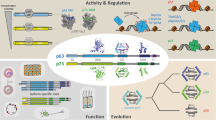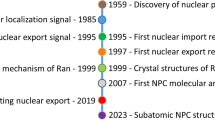Abstract
It has been reported that Lysine-305 is needed for the nuclear import of the p53 protein (Liang et al., 1998). In the present study, further mutagenesis analyses were carried out between Lys-305 and the major nuclear localization signal (NLS I) of p53. It was found that a single mutation of Arg-306 resulted in the defect of p53 nuclear import. This effect is the same as that of Lys-305 mutation. Other mutations between Arg-306 and NLS I have no effect on the nuclear import of p53. However, deletions of more than two amino acids between this region abolished the transport of p53 into the nucleus. These results indicate that a basic domain other than the well defined NLS is required for the nuclear import of p53. A spacer between this basic domain and NLS I is necessary for the entrance of p53 into the cell nucleus.
This is a preview of subscription content, access via your institution
Access options
Subscribe to this journal
Receive 50 print issues and online access
$259.00 per year
only $5.18 per issue
Buy this article
- Purchase on Springer Link
- Instant access to full article PDF
Prices may be subject to local taxes which are calculated during checkout





Similar content being viewed by others
References
Bosari S, Viale G, Roncalli M, Graziani D, Borsani G, Lee AKC and Coggi G. . 1995 Am. J. Pathol. 147: 790–798.
Carey KL, Richards SA, Lounsbury KM and Macara IG. . 1996 J. Cell Biol. 133: 985–996.
Dang CV and Lee WMF. . 1989 J. Biol. Chem. 264: 18019–18023.
Fornerod M, Ohno M, Yoshida M and Mattaj IW. . 1997 Cell 90: 1051–1061.
Görlich D and Mattaj IW. . 1996 Science 271: 1513–1518.
Hollstein M, Sidransky D, Vogelstein B and Harris CC. . 1991 Science 253: 49–53.
Horton R, Cai Z, Ho S and Pease L. . 1990 Biotechniques 8: 528–531.
Kalderon D, Roberts BL, Richardson WD and Smith AE. . 1984 Cell 39: 499–509.
Koepp DM and Silver PA. . 1996 Cell 87: 1–4.
Liang SH, Hong D and Clarke MF. . 1998 J. Biol. Chem. 273: 19817–19821.
Moll UM, Riou G and Levine AJ. . 1992 Proc. Natl. Acad. Sci. USA 89: 7262–7266.
Moll UM, LaQuaglia M, Benard J and Riou G. . 1995 Proc. Natl. Acad. Sci. USA 92: 4407–4411.
Robbins J, Dilworth SM, Laskey RA and Dingwall C. . 1991 Cell 64: 615–623.
Roberts BL, Richardson WD and Smith AE. . 1987 Cell 50: 465–475.
Ryan JJ, Prochownik E, Gottlieb CA, Apel IJ, Merino R, Nuñez G and Clarke MF. . 1994 Proc. Natl. Acad. Sci. USA 91: 5878–5882.
Shaulsky G, Ben-Ze'ev A and Rotter V. . 1990a Oncogene 5: 1707–1711.
Shaulsky G, Goldfinger N, Ben-Ze'ev A and Rotter V. . 1990b Mol. Cell. Biol. 10: 6565–6577.
Soussi T, Caron de Fromentel C and May P. . 1990 Oncogene 5: 945–952.
Soussi T and May P. . 1996 J. Mol. Biol. 260: 623–637.
Stade K, Ford CS, Guthrie C and Weis K. . 1997 Cell 90: 1041–1050.
Ullman KS, Powers MA and Forbes DJ. . 1997 Cell 90: 967–970.
Acknowledgements
This work was supported by NIH grant CA67140 from the NCI.
Author information
Authors and Affiliations
Rights and permissions
About this article
Cite this article
Liang, SH., Clarke, M. The nuclear import of p53 is determined by the presence of a basic domain and its relative position to the nuclear localization signal. Oncogene 18, 2163–2166 (1999). https://doi.org/10.1038/sj.onc.1202350
Received:
Revised:
Accepted:
Published:
Issue Date:
DOI: https://doi.org/10.1038/sj.onc.1202350
Keywords
This article is cited by
-
Disease-specific alteration of karyopherin-α subtype establishes feed-forward oncogenic signaling in head and neck squamous cell carcinoma
Oncogene (2020)
-
Exposure to chronic hyperglycemic conditions results in Ras-related C3 botulinum toxin substrate 1 (Rac1)-mediated activation of p53 and ATM kinase in pancreatic β-cells
Apoptosis (2017)
-
Mice defective in p53 nuclear localization signal 1 exhibit exencephaly
Transgenic Research (2011)
-
Evaluation of potential interactions between the metastasis-associated protein S100A4 and the tumor suppressor protein p53
Amino Acids (2011)
-
A high-content chemical screen identifies ellipticine as a modulator of p53 nuclear localization
Apoptosis (2008)



